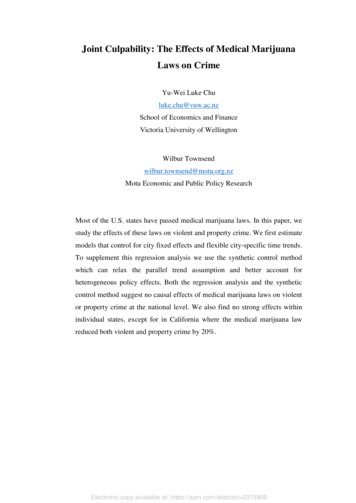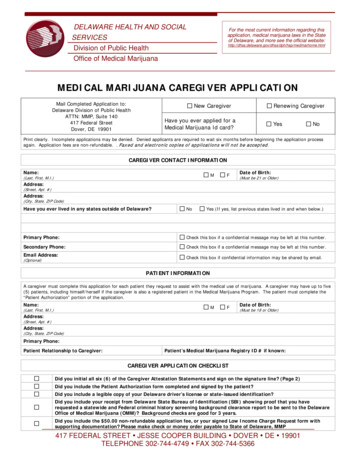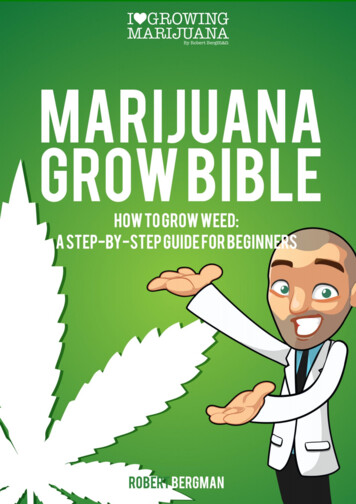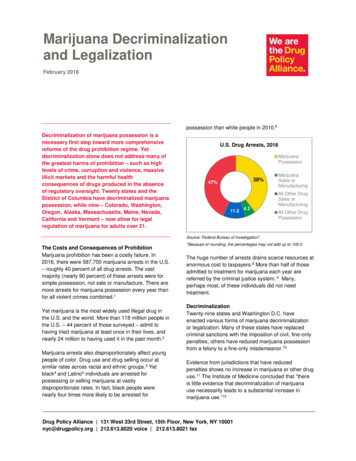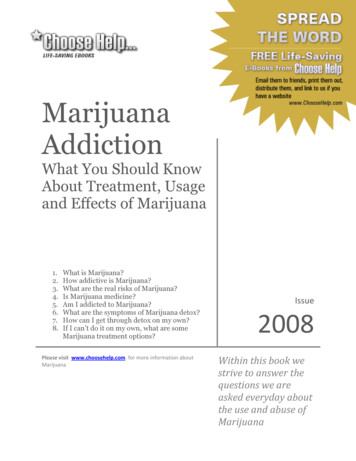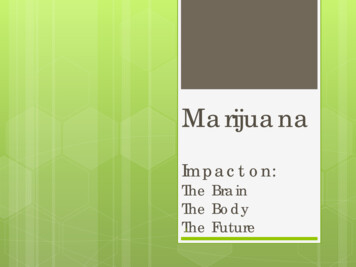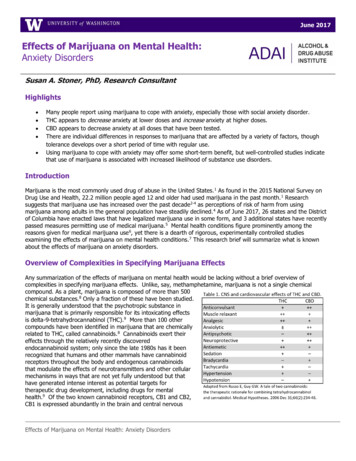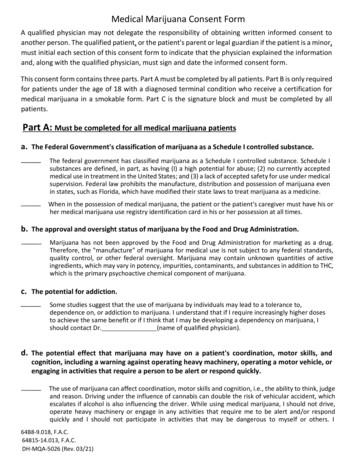
Transcription
Medical Marijuana Consent FormA qualified physician may not delegate the responsibility of obtaining written informed consent toanother person. The qualified patient, or the patient's parent or legal guardian if the patient is a minor,must initial each section of this consent form to indicate that the physician explained the informationand, along with the qualified physician, must sign and date the informed consent form.This consent form contains three parts. Part A must be completed by all patients. Part B is only requiredfor patients under the age of 18 with a diagnosed terminal condition who receive a certification formedical marijuana in a smokable form. Part C is the signature block and must be completed by allpatients.Part A: Must be completed for all medical marijuana patientsa. The Federal Government's classification of marijuana as a Schedule I controlled substance.The federal government has classified marijuana as a Schedule I controlled substance. Schedule Isubstances are defined, in part, as having (I) a high potential for abuse; (2) no currently acceptedmedical use in treatment in the United States; and (3) a lack of accepted safety for use under medicalsupervision. Federal law prohibits the manufacture, distribution and possession of marijuana evenin states, such as Florida, which have modified their state laws to treat marijuana as a medicine.When in the possession of medical marijuana, the patient or the patient's caregiver must have his orher medical marijuana use registry identification card in his or her possession at all times.b. The approval and oversight status of marijuana by the Food and Drug Administration.Marijuana has not been approved by the Food and Drug Administration for marketing as a drug.Therefore, the "manufacture" of marijuana for medical use is not subject to any federal standards,quality control, or other federal oversight. Marijuana may contain unknown quantities of activeingredients, which may vary in potency, impurities, contaminants, and substances in addition to THC,which is the primary psychoactive chemical component of marijuana.c. The potential for addiction.Some studies suggest that the use of marijuana by individuals may lead to a tolerance to,dependence on, or addiction to marijuana. I understand that if I require increasingly higher dosesto achieve the same benefit or if I think that I may be developing a dependency on marijuana, Ishould contact Dr.(name of qualified physician).d. The potential effect that marijuana may have on a patient's coordination, motor skills, andcognition, including a warning against operating heavy machinery, operating a motor vehicle, orengaging in activities that require a person to be alert or respond quickly.The use of marijuana can affect coordination, motor skills and cognition, i.e., the ability to think, judgeand reason. Driving under the influence of cannabis can double the risk of vehicular accident, whichescalates if alcohol is also influencing the driver. While using medical marijuana, I should not drive,operate heavy machinery or engage in any activities that require me to be alert and/or respondquickly and I should not participate in activities that may be dangerous to myself or others. I64B8‐9.018, F.A.C.64815‐14.013, F.A.C.DH‐MQA‐5026 (Rev. 03/21)
understand that if I drive while under the influence of marijuana, I can be arrested for "driving underthe influence."e. The potential side effects of medical marijuana use.Potential side effects from the use of marijuana include, but are not limited to, the following:dizziness, anxiety, confusion, sedation, low blood pressure, impairment of short term memory,euphoria, difficulty in completing complex tasks, suppression of the body's immune system, mayaffect the production of sex hormones that lead to adverse effects, inability to concentrate,impaired motor skills, paranoia, psychotic symptoms, general apathy, depression and/orrestlessness. Marijuana may exacerbate schizophrenia in persons predisposed to that disorder. Inaddition, the use of medical marijuana may cause me to talk or eat in excess, alter my perceptionof time and space and impair my judgment. Many medical authorities claim that use of medicalmarijuana, especially by persons younger than 25, can result in long‐term problems with attention,memory, learning, drug abuse, and schizophrenia.There is substantial evidence of a statistical association between long‐term cannabis smoking andworsening respiratory symptoms and more frequent chronic bronchitis episodes. Smokingmarijuana is associated with large airway inflammation, increased airway resistance, and lunghyperinflation. Smoking cannabis, much like smoking tobacco, can introduce levels of volatilechemicals and tar in the lungs that may raise concerns about the risk of cancer and lung disease.I understand that using marijuana while consuming alcohol is not recommended. Additional sideeffects may become present when using both alcohol and marijuana.I agree to contact Dr.if I experience any of the side effects listed above, orif I become depressedor psychotic, have suicidal thoughts, or experiencecrying spells. I will also contact Dr.if I experience respiratory problems,changes in my normal sleeping patterns, extreme fatigue, increased irritability, or begin towithdraw from my family and/or friends.f.The risks, benefits, and drug interactions of marijuana.Signs of withdrawal can include: feelings of depression, sadness, irritability, insomnia,restlessness, agitation, loss of appetite, trouble concentrating, sleep disturbances and unusualtiredness.Symptoms of marijuana overdose include, but are not limited to, nausea, vomiting, hackingcough, disturbances in heart rhythms, numbness in the hands, feet, arms or legs, anxietyattacks and incapacitation. If I experience these symptoms, I agree to contact Dr.immediately or go to the nearest emergency room.Numerous drugs are known to interact with marijuana and not all drug interactions are known.Some mixtures of medications can lead to serious and even fatal consequences.I agree to follow the directions of Dr.regarding the use of prescription and non‐prescription medication. I will advise any other of my treating physician(s) of my use of medicalmarijuana.64B8‐9.018, F.A.C.64815‐14.013, F.A.C.DH‐MQA‐5026 (Rev. 03/21)2
Marijuana may increase the risk of bleeding, low blood pressure, elevated blood sugar, liverenzymes, and other bodily systems when taken with herbs and supplements. I agree to contactDr.immediately or go to the nearest emergency room if these symptomsoccur.I understand that medical marijuana may have serious risks and may cause low birthweightor other abnormalities in babies. I will advise Dr.if I become pregnant,try to get pregnant, or will be breastfeeding.g. The current state of research on the efficacy of marijuana to treat the qualifying conditions setforth in this section.Cancer There is insufficient evidence to support or refute the conclusion that cannabinoids are an effectivetreatment for cancers, including glioma.There is evidence to suggest that cannabinoids (and the endocannabinoid system moregenerally) may play a role in the cancer regulation processes. Due to a lack of recent, high qualityreviews, a research gap exists concerning the effectiveness of cannabis or cannabinoids intreating cancer in general. There is conclusive evidence that oral cannabinoids are effective antiemetics in the treatment ofchemotherapy‐induced nausea and vomiting.There is insufficient evidence to support or refute the conclusion that cannabinoids are aneffective treatment for cancer‐associated anorexia‐cachexia syndrome and anorexia nervosa.Epilepsy There is insufficient evidence to support or refute the conclusion that cannabinoids are aneffective treatment for epilepsy.Recent systematic reviews were unable to identify any randomized controlled trials evaluatingthe efficacy of cannabinoids for the treatment of epilepsy. Currently available clinical datatherefore consist solely of uncontrolled case series, which do not provide high‐quality evidenceof efficacy. Randomized trials of the efficacy of cannabidiol for different forms of epilepsy havebeen completed and await publication.Glaucoma There is limited evidence that cannabinoids are an ineffective treatment for improving intraocularpressure associated with glaucoma.Lower intraocular pressure is a key target for glaucoma treatments. Nonrandomized studies inhealthy volunteers and glaucoma patients have shown short‐term reductions in intraocularpressure with oral, topical eye drops, and intravenous cannabinoids, suggesting the potential fortherapeutic benefit. A good‐quality systemic review identified a single small trial that found noeffect of two cannabinoids, given as an oromucosal spray, on intraocular pressure. The qualityof evidence for the finding of no effect is limited. However, to be effective, treatments targetinglower intraocular pressure must provide continual rather than transient reductions in intraocular64B8‐9.018, F.A.C.64815‐14.013, F.A.C.DH‐MQA‐5026 (Rev. 03/21)3
pressure. To date, those studies showing positive effects have shown only short‐term benefit onintraocular pressure (hours), suggesting a limited potential for cannabinoids in the treatment ofglaucoma.Positive status for human immunodeficiency virus There is limited evidence that cannabis and oral cannabinoids are effective in increasing appetiteand decreasing weight loss associated with HIV/AIDS.There does not appear to be good‐quality primary literature that reported on cannabis orcannabinoids as effective treatments for AIDS wasting syndrome.Acquired immune deficiency syndrome There is limited evidence that cannabis and oral cannabinoids are effective in increasing appetiteand decreasing weight loss associated with HIV/AIDS.There does not appear to be good‐quality primary literature that reported on cannabis orcannabinoids as effective treatments for AIDS wasting syndrome.Post‐traumatic stress disorder There is limited evidence (a single, small fair‐quality trial) that nabilone is effective for improvingsymptoms of posttraumatic stress disorderA single, small crossover trial suggests potential benefit from the pharmaceutical cannabinoidnabilone. This limited evidence is most applicable to male veterans and contrasts with non‐randomized studies showing limited evidence of a statistical association between cannabis use(plant derived forms) and increased severity of posttraumatic stress disorder symptoms amongindividuals with posttraumatic stress disorder. There are other trials that are in the process ofbeing conducted and if successfully completed, they will add substantially to the knowledgebase.Amyotrophic lateral sclerosis There is insufficient evidence that cannabinoids are an effective treatment for symptoms associatedwith amyotrophic lateral sclerosis.Two small studies investigated the effect of dronabinol on symptoms associated with ALS.Although there were no differences from placebo in either trial, the sample sizes were small,the duration of the studies was short, and the dose of dronabinol may have been too small toascertain any activity. The effect of cannabis was not investigated.Crohn's disease There is insufficient evidence to support or refute the conclusion that dronabinol is an effectivetreatment for the symptoms of irritable bowel syndrome.Some studies suggest that marijuana in the form of cannabidiol may be beneficial in thetreatment of inflammatory bowel diseases, including Crohn's disease.64B8‐9.018, F.A.C.64815‐14.013, F.A.C.DH‐MQA‐5026 (Rev. 03/21)4
Parkinson's disease There is insufficient evidence that cannabinoids are an effective treatment for the motor systemsymptoms associated with Parkinson's disease or the levodopainduced dyskinesia.Evidence suggests that the endocannabinoid system plays a meaningful role in certainneurodegenerative processes; thus, it may be useful to determine the efficacy of cannabinoidsin treating the symptoms of neurodegenerative diseases. Small trials of oral cannabinoidpreparations have demonstrated no benefit compared to a placebo in ameliorating the sideeffects of Parkinson's disease. A seven‐patient trial of nabilone suggested that it improved thedyskinesia associated with levodopa therapy, but the sample size limits the interpretation ofthe data. An observational study demonstrated improved outcomes, but the lack of a controlgroup and the small sample size are limitations.Multiple sclerosis There is substantial evidence that oral cannabinoids are an effective treatment for improvingpatient‐reported multiple sclerosis spasticity symptoms, but limited evidence for an effect onclinician‐measured spasticity.Based on evidence from randomized controlled trials included in systematic reviews, an oralcannabis extract, nabiximols, and orally administered THC are probably effective for reducingpatient‐reported spasticity scores in patients with MS. The effect appears to be modest. Theseagents have not consistently demonstrated a benefit on clinician‐measured spasticity indices.Medical conditions of same kind or class as or comparable to the abovequalifying medical conditions The qualifying physician has provided the patient or the patient's parent or legal guardian asummary of the current research on the efficacy of marijuana to treat the patient's medicalcondition.The summary is attached to this informed consent as AddendumTerminal conditions diagnosed by a physician other than the qualifiedphysician issuing the physician certification The qualifying physician has provided the patient or the patient's caregiver a summary of thecurrent research on the efficacy of marijuana to treat the patient's terminal condition.The summary is attached to this informed consent as AddendumChronic nonmalignant pain There is substantial evidence that cannabis is an effective treatment for chronic pain in adults.The majority of studies on pain evaluated nabiximols outside the United States. Only a handfulof studies have evaluated the use of cannabis in the UnitedStates. and all of them evaluated cannabis in flower form provided by the National Instituteon Drug Abuse. In contrast, many of the cannabis products that are sold in state‐regulatedmarkets bear little resemblance to the products that are available for research at the federallevel in the United States. Pain patients also use topical forms.64B8‐9.018, F.A.C.64815‐14.013, F.A.C.DH‐MQA‐5026 (Rev. 03/21)5
While the use of cannabis for the treatment of pain is supported by well controlled clinicaltrials, very little is known about the efficacy, dose, routes of administration, or side effectsof commonly used and commercially available cannabis products in the United States.h.That the patient's de‐identified health information contained in the physiciancertification and medical marijuana use registry may be used for researchpurposes.The Department of Health submits a data set to the Consortium for Medical Marijuana ClinicalOutcomes Research for each patient registered in the medical marijuana use registry that includesthe patient's qualifying medical condition and the daily dose amount and forms of marijuana certifiedfor the patient.PART B: Certification for medical marijuana in a smokable marijuana for a patient under18 with a diagnosed terminal condition.Initial here if you are not a patient under 18 with a diagnosed terminal condition who will be receivingmedical marijuana in a smokable form. After initialing here, complete part C.If the patient is under 18, has a diagnosed terminal condition, and will be receiving medical marijuanain a smokable form, please review and initial the remainder of Part B before completing Part C.Respiratory HealthExposures to tobacco smoke and household air pollution consistently ranks among the top risk factorsnot only for respiratory disease burden but also for the global burden of disease. Given the knownrelations ships between tobacco smoking and multiple respiratory conditions, one could hypothesize thatlong‐term cannabis smoking leads to similar deleterious effects of respiratory health, and someinvestigators ague that cannabis smoking may be even more harmful that of tobacco smoking. Datacollected from 15 volunteers suggest that smoking one cannabis joint can lead to four times the exposureto carbon monoxide and three to five times more tar deposition than smoking a single cigarette.Cognitive and Psychosocial DevelopmentResearchers are still studying the long‐term health effects of marijuana. Most people agree thatmarijuana use hurts adolescents more than adults. It is during the period of adolescence and youngadulthood that the neural substrates that underlie the development of cognition are most active.Adolescence marks one of the most impressive stretches of neural and behavioral change withsubstantial a protracted development in terms of both brain structure and function. As a result,cannabis and other substance use during this period may incur relatively greater interference inneural, social, and academic functioning compared to late developmental periods. There is moderate evidence of a statistical association between acute cannabis use andimpairment in the cognitive domains of learning, memory, and attention. There is limited evidence of a statistical association between sustain abstinence form cannabisuse and impairments in the cognitive domains of learning, memory, and attention.64B8‐9.018, F.A.C.64815‐14.013, F.A.C.DH‐MQA‐5026 (Rev. 03/21)6
There is limited evidence of a statistical association between cannabis use and impaired academicachievement and education outcomes. There is limited evidence of a statistical association between cannabis use and increased rates ofunemployment and/or low income. There is limited evidence of a statistical association between cannabis use and impaired socialfunctioning or engagement in developmentally appropriate social roles.AddictionMarijuana, like some other brain‐altering substances, can be addictive. Nearly one in 10 marijuanausers will become addicted. Starting to use marijuana at a younger age can lead to a greater risk ofdeveloping a substance use disorder later in life. Adolescents who begin using marijuana before age18 are four to seven times more likely than adults to develop a marijuana use disorder.Part C: For certification of smoking marijuana as an appropriate route of administration fora qualified patient, other than a patient diagnosed with a terminal conditionAcknowledgement of contaminant risks.Smokable marijuana has infectious risks that are not present in processed products. Certainmolds and mildews can contaminate marijuana plants during growing, processing, storage indispensaries and in patient homes. These contaminates can pose health risks, particularly tothose who are immunosuppressed due to their disease state and treatments. While the Stateof Florida requires third party testing you should still inspect your product.Respiratory Health.Exposures to tobacco smoke and household air pollution consistently ranks among the top riskfactors not only for respiratory disease burden but also for the global burden of disease. Giventhe known relations ships between tobacco smoking and multiple respiratory conditions, onecould hypothesize that long‐term marijuana smoking leads to similar deleterious effects ofrespiratory health, and some investigators ague that marijuana smoking may be even moreharmful that of tobacco smoking.Information regarding health risks of 2nd and 3rd hand smoke to other household members.You should never smoke medical marijuana around other family members, especially childrenand any household guests. You should smoke outside to allow adequate ventilation and tomitigate the dangers of secondhand and thirdhand smoke to others. Marijuana should never besmoked inside vehicles or other small spaces that children will occupy even if the children arenot present at the time the product is consumed.64B8‐9.018, F.A.C.64815‐14.013, F.A.C.DH‐MQA‐5026 (Rev. 03/21)7
Dangers of smoking marijuana in households where oxygen is in use.If you use oxygen or have others in your household who use oxygen you should not smokemarijuana or any other combustible material in the vicinity of where the oxygen is in use due tothe risk of fire and explosion.Self‐dosing, if permitted.I have been given instructions or discussed guidance on self‐ dosing with my qualified physicianif permitted to do so.Part D:Must be completed for all medical marijuana patientsI have had the opportunity to discuss these matters with the physician and to ask questionsregarding anything I may not understand or that I believe needed to be clarified. I acknowledgethat Dr.has informed me of the nature of a recommended treatment,including but not limited to, any recommendation regarding medical marijuana.Dr.also informed me of the risks, complications, and expected benefits of anyrecommended treatment, including its likelihood of success and failure. I acknowledge that Dr.informed me of any alternatives to the recommended treatment, including thealternative of no treatment, and the risks and benefits. Dr.hasexplained the information in this consent form about the medical use of marijuana.Patient (print name)Patient signature or signature of the parent or legal guardian if the patient is a minor:DateI have explained the information in this consent form about the medical use of marijuana to(Print patient name).Qualified physician signature:DateWitness:Date64B8‐9.018, F.A.C.64815‐14.013, F.A.C.DH‐MQA‐5026 (Rev. 03/21)8
The potential for addiction. Some studies suggest that the use of marijuana by individuals may lead to a tolerance to, dependence on, or addiction to marijuana. I understand that if I require increasingly higher doses to achieve the same benefit or if I think that I may be developing a dependency on marijuana, I
